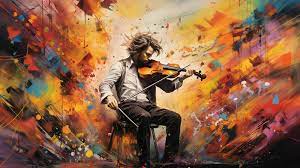In the realm of creative expression, artificial intelligence (AI) has emerged as a powerful force, transcending its traditional role as a tool for automation and analysis. This article explores the fascinating evolution of AI-generated art, examining how algorithms are being utilized to create paintings, music, and other forms of artistic expression, pushing the boundaries of what is possible in the creative world.
Introduction
Artificial intelligence, once confined to the domain of data analysis and problem-solving, has found its way into the realm of artistic creation. From visual arts to musical compositions, AI-generated art is challenging preconceived notions about the role of machines in the creative process. This intersection of technology and art opens doors to new possibilities and sparks intriguing questions about the nature of creativity.
Style Transfer Algorithms
One notable application of AI in visual arts is the use of style transfer algorithms. These algorithms analyze the characteristics of famous artworks and apply their distinctive styles to new, original compositions. The result is a fusion of artistic styles, creating paintings that are both innovative and reminiscent of masterpieces from different periods.
Generative Adversarial Networks (GANs)
Generative Adversarial Networks, or GANs, have gained prominence in generating visually striking art. GANs consist of two neural networks—one generates images, and the other evaluates them. This dynamic interplay results in the creation of unique and often surreal artworks, showcasing the AI’s ability to produce novel visual concepts.
Algorithmic Composition
AI algorithms are making waves in the world of music composition. These algorithms analyze vast datasets of musical pieces, identifying patterns and structures. Through machine learning, AI can compose original pieces of music, exploring genres and styles with a level of complexity that challenges traditional notions of composition.
Neural Networks in Music Generation
Neural networks are being employed to create music that goes beyond simple algorithmic patterns. These networks, trained on extensive musical databases, can understand the nuances of different genres and even mimic the styles of specific composers. The result is AI-generated music that resonates with both innovation and familiarity.
Visual-Audio Synthesis
One of the intriguing developments in AI-generated art is the synthesis of visual and audio elements. Algorithms can generate visual representations based on musical input or create music inspired by visual stimuli. This cross-disciplinary approach blurs the lines between different forms of art, offering new avenues for multisensory creative expression.
AI-Driven Interactive Art Installations
AI is not limited to creating static artworks or compositions. Interactive art installations leverage AI to respond dynamically to audience interactions. These installations, whether in galleries or virtual spaces, engage viewers in a dialogue with the artwork, adapting and evolving based on real-time inputs.
Originality and Creativity
The use of AI in art raises philosophical questions about originality and creativity. Can AI truly create something genuinely original, or is it merely replicating existing patterns? The debate continues among artists, critics, and scholars.
Ethical Considerations
As AI-generated art gains popularity, ethical considerations come to the forefront. Issues of copyright, attribution, and the potential for AI to mimic the styles of living artists raise complex ethical questions that the art world is grappling with.
AI as a Collaborative Tool
The future of AI in art may involve collaboration rather than competition. Many artists and musicians view AI as a tool to augment their creative processes, providing inspiration, generating ideas, and pushing the boundaries of what is conceivable.
Advancements in Realism and Complexity
As AI algorithms become more sophisticated, the realism and complexity of AI-generated art are expected to advance. From paintings that closely mimic specific art movements to music compositions that evoke specific genres with uncanny accuracy, the potential for AI in the creative realm is vast.
Conclusion
AI-generated art is a testament to the transformative power of technology in the creative domain. Whether it’s paintings that blend the styles of the old masters or music compositions that defy traditional conventions, AI is reshaping our understanding of what is achievable in art. As artists and technologists continue to collaborate and innovate, the future promises a rich tapestry of AI-infused creativity that challenges, inspires, and expands the horizons of artistic expression.
FAQs
What are style transfer algorithms in AI-generated art?
Style transfer algorithms in AI-generated art analyze the characteristics of famous artworks and apply their distinctive styles to new, original compositions. This creates paintings that fuse different artistic styles, resulting in innovative and visually striking artworks.
How do Generative Adversarial Networks (GANs) contribute to AI-generated art?
GANs consist of two neural networks—one generates images, and the other evaluates them. This dynamic interplay results in the creation of unique and often surreal artworks. GANs contribute to AI-generated art by producing visually striking and novel compositions.
How does AI contribute to music composition?
AI contributes to music composition through algorithmic analysis of musical datasets and the use of neural networks. These technologies enable AI to compose original pieces of music
